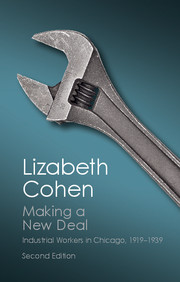
-
Select format
-
- Publisher:
- Cambridge University Press
- Publication date:
- October 2014
- November 2014
- ISBN:
- 9781139923460
- 9781107431799
- Dimensions:
- Weight & Pages:
- Dimensions:
- (216 x 138 mm)
- Weight & Pages:
- 0.79kg, 566 Pages
- Subjects:
- American History: General Interest, Area Studies, American Studies, History, Twentieth Century American History, General
- Series:
- Canto Classics
You may already have access via personal or institutional login- Subjects:
- American History: General Interest, Area Studies, American Studies, History, Twentieth Century American History, General
- Series:
- Canto Classics
Book description
This book examines how it was possible and what it meant for ordinary factory workers to become effective unionists and national political participants by the mid-1930s. We follow Chicago workers as they make choices about whether to attend ethnic benefit society meetings or to go to the movies, whether to shop in local neighborhood stores or patronize the new A & P. As they made daily decisions like these, they declared their loyalty in ways that would ultimately have political significance. When the depression worsened in the 1930s, workers adopted new ideological perspectives and overcame longstanding divisions among themselves to mount new kinds of collective action. Chicago workers' experiences all converged to make them into New Deal Democrats and CIO unionists. First printed in 1990, Making a New Deal has become an established classic in American history. The second edition includes a new preface by Lizabeth Cohen.
Reviews
Review of previous edition:'At every step the argument is developed in a sophisticated way … Making a New Deal constitutes a major achievement.'
Julia Greene Source: Journal of American History
Contents
Metrics
Full text views
Full text views help Loading metrics...
Loading metrics...
* Views captured on Cambridge Core between #date#. This data will be updated every 24 hours.
Usage data cannot currently be displayed.
Accessibility standard: Unknown
Why this information is here
This section outlines the accessibility features of this content - including support for screen readers, full keyboard navigation and high-contrast display options. This may not be relevant for you.
Accessibility Information
Accessibility compliance for the PDF of this book is currently unknown and may be updated in the future.


